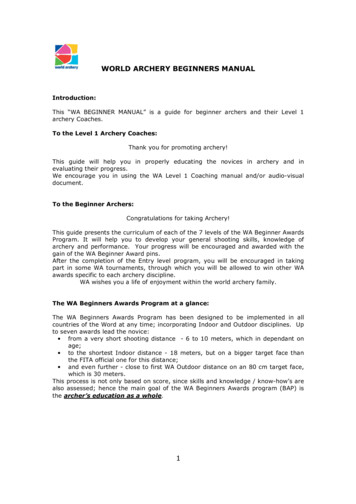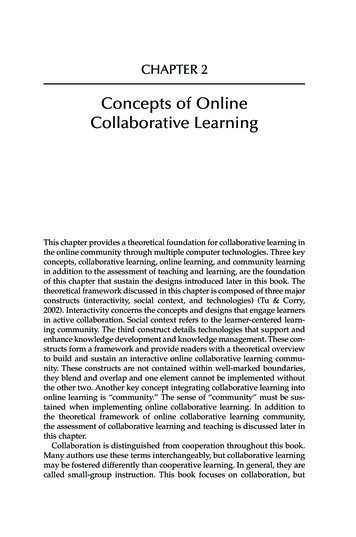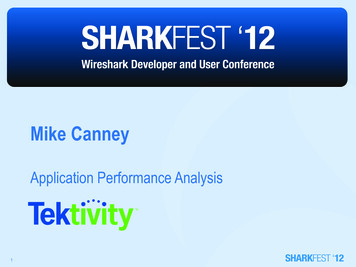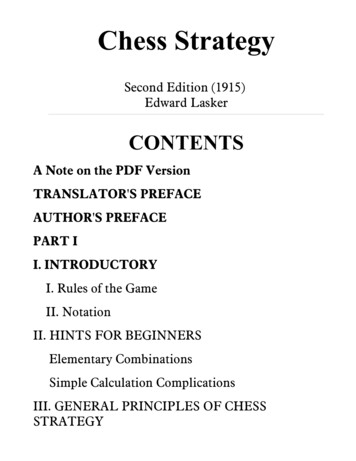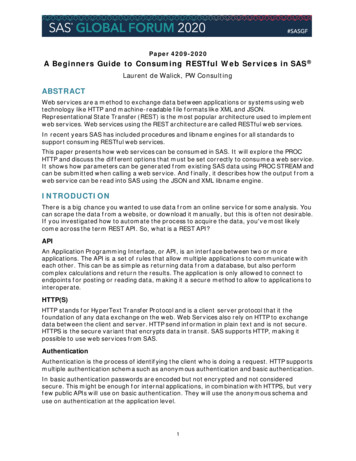
Transcription
Paper 4209-2020A Beginners Guide to Consuming RESTful Web Services in SAS Laurent de Walick, PW ConsultingABSTRACTWeb services are a method to exchange data between applications or systems using webtechnology like HTTP and machine-readable f ile f ormats like XML and JSON.Representational State Transfer (REST) is the most popular architecture used to implementweb services. Web services using the REST architecture are called RESTful web services.In recent years SAS has included procedures and libname engines f or all standards tosupport consuming RESTful web services.This paper presents how web services can be consumed in SAS. It will explore the PROCHTTP and discuss the dif f erent options that must be set correctly to consume a web service.It shows how parameters can be generated f rom existing SAS data using PROC STREAM andcan be submitted when calling a web service. And f inally, it describes how the output f rom aweb service can be read into SAS using the JSON and XML libname engine.INTRODUCTIONThere is a big chance you wanted to use data f rom an online service f or some analysis. Youcan scrape the data f rom a website, or download it manually, but this is of ten not desirable.If you investigated how to automate the process to acquire the data, you've most likelycome across the term REST API. So, what is a REST API?APIAn Application Programming Interface, or API, is an interf ace between two or moreapplications. The API is a set of rules that allow multiple applications to communicate witheach other. This can be as simple as returning data f rom a database, but also performcomplex calculations and return the results. The application is only allowed to connect toendpoints f or posting or reading data, making it a secure method to allow to applications tointeroperate.HTTP(S)HTTP stands f or HyperText Transfer Protocol and is a client server protocol that it thef oundation of any data exchange on the web. Web Services also rely on HTTP to exchangedata between the client and server. HTTP send inf ormation in plain text and is not secure.HTTPS is the secure variant that encrypts data in transit. SAS supports HTTP, making itpossible to use web services from SAS.AuthenticationAuthentication is the process of identif ying the client who is doing a request. HTTP supportsmultiple authentication schema such as anonymous authentication and basic authentication.In basic authentication passwords are encoded but not encrypted and not consideredsecure. This might be enough f or internal applications, in combination with HTTPS, but veryf ew public APIs will use on basic authentication. They will use the anonymous schema anduse on authentication at the application level.1
RESTThe most popular API standard f or web applications is REST. This determines how the APIlooks like. REST stands f or Representational State Transfer and was defined in 2000 by RoyFielding in his PhD dissertation "Architectural Styles and the Design of Netw ork-basedSof tware Architectures" [1].The REST architecture is based on a client/server model. A stateless protocol is used f orcommunication between client and server. Accessing a REST web service is called a request.The data returned by the web service is the response.RequestA request consists of 4 elements endpoint header method data (optional)EndpointThe endpoint is the internet address where the web service can be accessed. It is Unif ormAddress Location (URL) and typically has the f ollowing f pe free&sort lastnameIn the above example the root-endpoint is https://api.example.url and/users/memberships are the path to a specif ic web service. The f inal part of the endpoint,?filter free&sort lastname, is optional. This the query string and can be used to addparameters to the web service.MethodThe method def ines the type op request send to a web server. It indicates the action toperf orm f or the requested resource. Possible actions are Create, Read, Update or Delete(CRUD). The method that supports those actions are GET, POST, PUT, PATCH and DELETE.Methods are case sensitive and should always be upper cased.MethodGETPOSTPUT or PATCHDELETEType of actionRead a representation of a resource. The web servicelooks f or data and sends the results back.Create new resources; Create new entries in thedatabaseUpdate existing resources; Change existing records inthe databaseDelete a resource; Remove records f rom the databaseTable 1. Common methodsNot all web services accept all methods. Each web service should have documentationavailable that describes what method is valid.For example, the f ollowing request will return a list of all available users.GET https://api.example.url/users/2
In the next example a new user with the name Mike will be created.POST https://api.example.url/users/mikeHeaderHeaders are used to send additional inf ormation to with a request. The inf ormation isneeded by the server to understand how it should process the request. A header consistsname-value pairs that are f ormatted by its case-insensitive name f ollowed by a colon (:)and then by its value. A header can contain any number of name-value pairs.The f ollowing header tells the server that the server can expect data in the JSON f ormat(Content-Type), but that the client expects the result to be in XML (Accept)."Content-Type: application/json""Accept: application/xml"DataThe data, also called the body, message or payload, contains inf ormation that is send to theserver. Data is only valid when using the POST, PUT, PATCH or DELETE methods.ResponseThe response consists of a header and data. Each response also has a status code indicatinghow the request was handled.HTTP Status CodesThe status codes are part of the HTTP protocol and can be used to determine quickly if arequest has been complete successfully or f ailed and why. The status codes are gr ouped inf ive classes: Inf ormational responses (100–199) Successful responses (200–299) Redirects (300–399) Client errors (400–499) Server errors (500–599)Most status codes are defined in the HTTP/1.1 standard (RFC 7231), but servers can returnnon-standard code. If the code is not standard, the client should be able to determine thetype of errors by the class.JSONIn the past XML was the de f acto standard used to exchange data between systems. Therise of SOAP as the def ault f or APIs was an important driver f or the popularity of XML. Theintroduction of REST was paired to the rise of JavaScript Object Notation (JSON) as f ormatf or data exchange.JSON is an open-standard file f ormat or data interchange f ormat that uses human-readabletext to transmit or store data objects consisting of attribute–value pairs and array datatypes. It is lightweight and the most common data f ormat used by REST web services.The REST architecture does not mandate the use of a specif ic format to exchange data.Both JSON and XML can be used and it's up to the published of the service to select thedesired f ormat.3
JSON versus XML Both JSON and XML are "self -describing" Both JSON and XML are hierarchical Both JSON and XML have well-documented open standards (RFC 7159, RFC 4825) JSON is smaller. For the same data, JSON is almost always signif icantly smaller, leadingto f aster transmission and processing. XML separates data f rom metadata via the use of attributes and elements XML supports mixed contentCONSUMING WEB SERVICES USING SASNow that the basic concepts have been explained it's time to discuss how web services canbe access from SAS. REST web services use HTTP and SAS provides to methods to accessURLs over HTTP: The FILENAME statement with URL access method The HTTP procedureThe f ilename statement only supports the GET method and can only be used to read data.PROC HTTP supports any method that conforms to the HTTP standard and can be used f orthe other methods.GET REQUESTIn the f irst example we will do a get request to The Open Brewery DB [2]. The OpenBrewery DB is a f ree API f or public inf ormation on breweries, cideries, brewpubs, and bottleshops. In the f ollowing example we will use the API to retrieve a list of Brewpubs in citiesnamed Washington. This is access f rom the f ollowing y city washington&by type brewpubFILENAME statementThe FILENAME statement with the URL access method creates a f ile reference to an onlinelocation. The FILENAME statement uses the f ollowing syntax:FILENAME fileref URL http://url.to/web-service-endpoint ' url-options ;We use a data step to read its contents and write them to the SAS log. We also add theDEBUG option to have the HTTP headers written to the log.FILENAME request HTTP'http://api.openbrewerydb.org/breweries?by city washington&by type brewpub'DEBUG;DATA NULL ;INFILE request;INPUT;PUT INFILE ;RUN;When run, the code returns the f ollowing output to the log:4
NOTE: GET /breweries?by city washington&by type brewpub HTTP/1.0NOTE: Host: api.openbrewerydb.orgNOTE: Accept: */*NOTE: Accept-Language: enNOTE: Accept-Charset: iso-8859-1,*,utf-8NOTE: User-Agent: SAS/URLNOTE: NOTE: HTTP/1.1 200 OKNOTE: Date: Fri, 07 Feb 2020 09:22:28 GMTNOTE: Content-Type: application/json; charset utf-8NOTE: Connection: closeNOTE: Set-Cookie: cfduid s Sun, 08-Mar-20 09:22:27 GMT; path /;domain .openbrewerydb.org; HttpOnly; SameSite Lax; SecureNOTE: Cache-Control: max-age 86400, publicNOTE: Etag: W/"fab459aaa6d4afec7b8ccb593d6eec4b"NOTE: X-Request-Id: 266e578e-1eab-4010-bd23-a3014d9d0163NOTE: X-Runtime: 0.414939NOTE: Strict-Transport-Security: max-age 31536000; includeSubDomainsNOTE: Vary: OriginNOTE: Via: 1.1 vegurNOTE: CF-Cache-Status: DYNAMICNOTE: Expect-CT: max-age 604800, report-uri xpect-ct"NOTE: Server: cloudflareNOTE: CF-RAY: 56144ca9dc231762-FRANOTE: NOTE: The infile REQUEST is:Filename http://api.openbrewerydb.org/breweries?by city washington&by type brewpub,Local Host Name sasglobalforum2020.paper.host,Local Host IP addr 10.10.10.10,Service Hostname Name api.openbrewerydb.org,Service IP addr 104.24.124.147,Service Name N/A,Service Portno 443,Lrecl 32767,Recfm Variable[{"id":1768,"name":"Bluejacket","brewery type":"brewpub","street":"300Tingey St SE","city":"Washington","state":"District of Columbia","postal code":"20003-4625","country":"United 50965","phone":"","website url":"http://www.bluejacketdc.com","updated at":"2018-0824T00:26:14.349Z","tag list":[]},.{"id":1774,"name":"Gordon Biersch Brewery Restaurant - NavyYard","brewery type":"brewpub","street":"100 M St SE","city":"Washington","state":"District ofColumbia","postal code":"20003-3519","country":"United 66834","phone":"2024842739","website yard?action view","updated at":"2018-08-24T00:26:16.619Z","tag list":[]}]NOTE: 1 record was read from the infile REQUEST.The minimum record length was 3763.The maximum record length was 3763.5
Let's examine the output. 3 lines are highlighted yellow are discussed next.The f irst highlighted line is f rom the header send by SAS to the server in the request. SAStells the server that it accepts any kind of data.NOTE: Accept: */*The next line is the HTTP status code returned with the response. The return code is 200 OKindicating that the request was successful.NOTE: HTTP/1.1 200 OKThe third and last highlighted line tells SAS that the output in the response is in json f ormatand in the UTF-8 character set.NOTE: Content-Type: application/json; charset utf-8The data in the response is highlighted in gray. This is the JSON f ile that the web servicesreturned. To be able to process the data we don't want the output written to the SAS log,but need it in a dataset.LIBNAME JSON EngineSAS introduced the JSON LIBNAME engine in Maintenance 4 of SAS 9.4. With the libnameengine it is possible to read data f rom JSON like it is a data set. It is a read-only library andthe JSON f ile is read only once, when the JSON engine LIBNAME statement is assigned. Toread the JSON f ile again, you must reassign the JSON libref .For the brewpub request the LIBNAME statement has the f ollowing f ormat:LIBNAME brewpub JSON FILEREF request;This creates a library with several tables. Because the content is dif f erent f or each JSON f ile,the libname engine always creates an ALLDATA and ROOT and root table. Other tables arecreated based on the data in the JSON f ile. It's like the XML engine some people might bef amiliar with. For the Open Breweries API this is the results:6
Display 1 Contents of the BREWPUB libraryIn this case the JSON structure is f lat and all data is in the ROOT table. The next code printsa list of brewpubs in Washington DC:proc print data brewpub.root (where (state 'District of Columbia'));var name street phone;run;That leads to the f ollowing results:Output 1 Contents of the ROOT data set7
HTTP ProcedurePROC HTTP can be used f or more complex HTTP request, but nothing prohibits f rom using itf or simple GET requests too. PROC HTTP has the f ollowing syntax;proc httpurl "http://url.to/web.service.endpoint"method POSTin requestout response;headers"Content-Type" "application/json""Accept" "application/json";run;The next code retrieves all breweries in Washington. The arguments provided to PROC HTTPare: URL: The endpoint of the web service the request if f or. This is the only mandatoryargument. Method: The method used in the request. GET is the def ault value and the argument canbe omitted in this case. Out: The destination of the output. In this case we create a f ile ref erence to temporarylocation and assign a JSON libname to the response f ileref.filename response temp;proc httpurl "https://api.openbrewerydb.org/breweries?by city Washington"method GETout response;run;The response is a JSON f ile with inf ormation about all the Washington breweries.[{"id": 1767,"name": "Bardo Brewpub","brewery type": "micro","street": "25 Potomac Ave SE","city": "Washington", "phone": "","website url": "","updated at": "2018-08-11T21:39:47.705Z","tag list": []}]The LIBNAME JSON engine can be used again to make the data in the JSON f ile useable inSAS.8
POST REQUESTThe GET request is easy to use but has limited possibilities. In the next example the requestis a post request where data is sent in the body. The data in the body is a new personrecords this is "saved" in the database. The example uses the f ree Dummy Rest APIExample [3] service that simulates a POST action and does not actually write the create to adatabase.The body is a JSON f ile that is placed somewhere on the SAS server. The JSON f ile lookslike:{"name":"Laurent","age":"40"}PROC HTTP is used to use the web server. A POST request is done where the JSON is sendas body content. The PROC HTTP requires the next arguments URL: Endpoint to the web service Method: POST In: File ref erence to the JSON that is send as body content Out: File ref erence to the results that are returned by the web service CT: The mime type of the body, in this case application/json because our body contentis in the JSON f ormat. PROC HTTP also has a debug option. In this case it's set to 1.filename payload '/data/payload.json';proc httpurl hod "POST"in payloadout responsect "application/json";debug level 1;run;When executed the f ollowing is written to the log: POST /api/v1/create HTTP/1.1User-Agent: SAS/9Host: dummy.restapiexample.comAccept: */*Connection: Keep-AliveContent-Length: 56Content-Type: application/jsonHTTP/1.1 200 OKAccept-Ranges: bytesAccess-Control-Allow-Origin: *Cache-Control: no-store, no-cache, must-revalidateContent-Type: application/json;charset utf-8Date: Fri, 07 Feb 2020 12:35:34 GMTExpires: Thu, 19 Nov 1981 08:52:00 GMTHost-Header: c2hhcmVkLmJsdWVob3N0LmNvbQ 9
Server: nginx/1.16.0 NOTE: PROCEDURE HTTP used (Total process time):real time0.59 secondscpu time0.04 secondsThe highlighted parts in f rom the log tells that a POST request was done with a bodycontaining JSON. The request was successful (200 HTTP status code) and JSON body wasreturned.The JSON body contains the f ollowing :{"status": "success","data": {"name": "Laurent","salary": null,"age": "40","id": 99}}Name and age correspond to the values I put in the body. Because no salary was posted itis set to null by the service. A new id is generated f or the record.DELETE RequestThe DELETE request is like a GET request. An endpoint is accessed with the DELETE methodand a record is deleted f rom the database.proc httpurl method "DELETE"out responsect "application/json";debug level 1;run;ADDITIONAL OPTIONSJSON mapsThe JSON libname engine has an automap f unction that generates a data set f or each objectin the JSON. It also generates a data set named ALLDATA, which contains all JSONinf ormation in a single data set.There are situations where the automap f unction is not the optimal solution to organize datain library. Complex hierarchies in the JSON f ile can lead to many datasets and datatypes arenot always determined correctly. To improve data management the JSON libname enginehas the possibility to provide a map f ile that that maps the data in data sets according to auser def inition. In addition, the map f ile can be used to set the length, f ormat and inf ormatof each column.Using a map f ile can also improve performance when assigning a library on large JSON f iles.The automap f unction needs to read and parse all data to be able to determine what datasets are created. A JSON map contains this inf ormation and reduces the initial work.10
The 2018 Global Forum Paper "Using Maps with the JSON LIBNAME Engine in SAS" [4]explains in more detail how a JSON map can be created.XMLExtensible Markup Language (XML) is a markup language to create documents that are bothhuman and machine-readable. The specification f or XML is def ined in a f ree and openstandard. XML is widely used f or the representation of arbitrary data structures such asthose used in web services [5].Many standards use XML to structure and exchange data. As a result, XML is also a commonf ormat to exchange data using REST APIs. SAS has been able to process XML since SAS 9.1using a libname engine. In SAS 9.2 an improved version of the libname engine wasintroduced.The XML Libname engine works much like the JSON LIBNAME Engine. It also has anautomap f eature that generates data sets based on the contents and supports map f iles todescribe data and have a user def ine the contents of the library. A libref f or the XMLV2engine can be assigned to either a specif ic XML document or to the physical location of aSAS library in a directory-based environment. [6]LIBNAME response XMLV2 XMLFILEREF response XMLMAP mapflref;AuthenticationMany web services require the consumer to authenticate before a service can be consumed.The FILENAME statement with URL Access method only supports basic authentication whilePROC HTTP supports most common authentication methods. Basic Authentication: Uses the WEBUSERNAME and WEBPASSWORD arguments tosubmit the correct credentials in the HTTP call. NTLM or Kerberos: Uses the current user running the SAS process to authenticate. OATH BEARER: For service that user OAuth authentication.OAuth AuthenticationMany web services are moving to OAuth f or authentication. OAuth is an open standardauthorization f ramework that allows a user to grant a website or application limited accessto an HTTP service. OAuth works using tokens to authenticate and authorize an applicationto access a serviceThe 2017 SAS Global Forum Paper "Show Off Your OAuth" [2] contains a step by stepexplanation on how to implement OAuth in SAS.ProxyMany SAS servers can only access outside service through a HTTP proxy server. If this isthe case the proxy server and optional credentials can be provided in PROC HTTP. PROXYHOST: The hostname of the proxy server PROXYPORT: The port the proxy server listens to PROXYUSERNAME: A username required to login to the proxy server (optional, onlyneeded if server requires credentials) PROXYPASSWORD: The password f or the username11
CONCLUSIONImprovements in PROC HTTP and the addition of the JSON libname engine has simplif iedthe use of REST APIs in SAS. With many REST web services available online, adding thirdparty or open data to SAS projects has never been easier.REFERENCES[1] Wikipedia, “Representational State Transfer,” 2019. [Online]. tional state transfer.[2] “Open Brewery DB API Documentation,” [Online]. ion.[3] “Dummy Rest API Example,” [Online]. Available: http://dummy.restapiexample.com/.[4] A. Gannon, “Using Maps with the JSON LIBNAME Engine in SAS,” in SAS Global Forum, 2018.[5] Wikipedia, “XML,” [Online]. Available: https://en.wikipedia.org/wiki/XML.[6] J. Henry, “Show Off Your OAuth,” in SAS Global Forum, 2017.[7] SAS, “LIBNAME Statement: JSON Engine,” in SAS 9.4 Global Statements: Reference, 2020.[8] SAS, SAS 9.4 XMLV2 and XML LIBNAME Engines: User’s Guide, 2020.[9] SAS, “HTTP Procedure,” in Base SAS 9.4 Procedures Guide, Seventh Edition, 2020.RECOMMENDED READING Base SAS Procedures Guide SAS 9.4 XMLV2 and XML LIBNAME Engines: User’s GuideCONTACT INFORMATIONYour comments and questions are valued and encouraged. Contact the author at:Laurent de WalickPW /www.pwconsulting.nlSAS and all other SAS Institute Inc. product or service names are registered trademarks ortrademarks of SAS Institute Inc. in the USA and other countries. indicates USAregistration.Other brand and product names are trademarks of their respective companies.12
A Beginners Guide to Consuming RESTful Web Services in SAS . An Application Programming Interface, or API, is an interface between two or more applications. The API is a set of rules that allow multiple applications to communicate with each other. This can be as s
